Q&A – Ask Neil: October 13, 2022
(Please read these instructions carefully.)
Before you post your question, please look at recent issues to see if someone else has already asked it. You might find your answer there.
How to submit your question…
• Click here to post your question.
• After you submit your question, a new window will pop up giving you the address to which you can e-mail a photo to accompany your question. Clear, medium-resolution photos. (Try to avoid low-res thumbnail photos, please, in case I have to zoom in to see things.)
• Please only post your question one time.
• One question per reader, please.
• Please use this only for posting questions – not for standard emails.
• Watch for your answer in the following week’s e-gardens.
• I choose those of greatest general interest. For example, plant IDs seldom make the cut.
• I must have your first name or initials.
• I must have your city or county. (Texas is a very large state.)
QUESTION 1
CAN LANTANA AND LAVENDER BE TRIMMED NOW?
Question: I have a huge bed of lantana and lavender. I want to install drip irrigation via conversion from a sprinkler system. I usually trim both in February to stem lengths about 8 inches. To help with line laying can I trim them now? Would that cause problems? MA C., Tarrant County.
Answer: It surely would be better if you could wait 4 or 5 weeks for the first killing freeze. However, if you must do it now, they will probably survive. For what it’s worth, I personally would leave the sprinkler heads in place for a year or two just in case you ever want to go back. I see so many drip lines that fail to meet needs after a period of time.
QUESTION 2
WHAT DO YELLOW SPOTS AND BLOTCHES ON LEAVES OF CORN PLANT DRACAENA TELL US?
Question: I have a 40-year-old corn plant dracaena that has recently developed yellow spots and blotches of light green through many of its leaves. I know brown tips mean they need more water, but these problems are all over the leaves. What is wrong? Dorothy C., Grayson Co.
Answer: That can also be moisture stress. Odds of its being a disease are very small in an indoor setting. I pass by a corn plant several times weekly in an office building and I’ve watched it struggle with moisture deficiencies over the past couple of years. It is doing exactly what you are describing. I sneak a glass of water to it whenever I can. In your case, is there any chance your plant has become rootbound? Do you leach the excess mineral salts out of the pot every fourth or fifth time that you water? Both of those could lead to moisture stress issues and root damage.
QUESTION 3
HOW CAN I TRAIN NEW SHOOTS FROM LIVE OAKS TO BE NEW TRUNKS FOR TREES?
Question: I have two small live oaks that froze in February 2021. They have put up root sprouts that are very vigorous today. How should I plan to thin the shoots down to final “trees?” Jeannette P., Abilene.
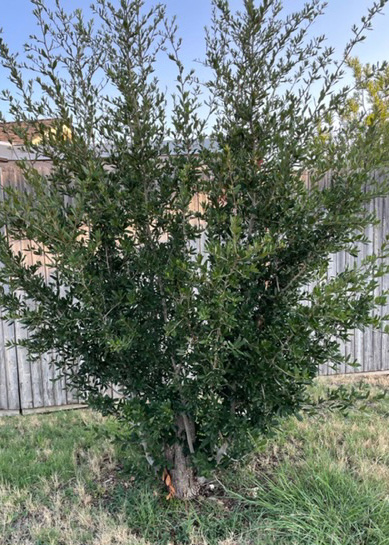
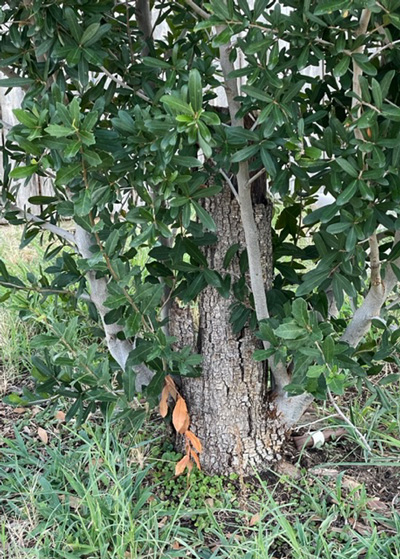
Answer: These would be categorized as “basal” sprouts, originating from the trunk and not from the roots. They really do look vigorous so I’m pretty sure they will be able to stand on their own. You will want to select the straightest strong one on each tree and remove all the others. By that I mean the one that leans out away from the old trunk in the smallest angle. You will still have decided crooks in each trunk after you finish, but you’ll be amazed at how quickly those crooks will be absorbed by the trunks as they grow in diameter. My bet is that they won’t even be noticeable in 3 or 4 years.
QUESTION 4
MY TREES (NOT PECANS) HAVE SHINY LEAVES AND THE STREET IS STICKY. THEY DO NOT HAVE MOLD.
Question: I read what you said about pecan aphids. I do not have pecans, but we have some trees that are shiny with, I guess sap that is covering the street and so sticky when we walk over it. The leaves do not have the mold like in your picture. Beth, Scroggins.
Answer: I’m not sure if you had a question. Several tree species, including pecans, walnuts, oaks, elms and others have aphids, lacebugs and other insects that exude sticky honeydew (not really sap) that coats anything beneath them. The sooty mold fungus develops in the honeydew after several weeks/several months. (A soaking rain should take care of it.)
QUESTION 5
IS THIS STILL FREEZE DAMAGE TO MY OAK?
Question: I’ve recently noticed this damage to my 40-year-old oak tree. Is this caused by the February 2021 cold? Is there anything that should be done to minimize the damage? Ed. G., Dallas.
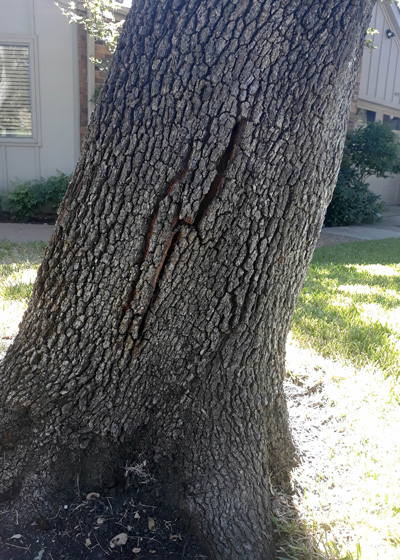
Answer: Yes. This is the radial shake damage you may have seen me address here several times. At this point all you can do is wait to see how well the tree does come out in the spring and into the future. If it has most of its leaf canopy it should be fine, but if it’s thinning you need to be more concerned. You may want to have a certified arborist look at the tree to be sure it’s not a hazard.
QUESTION 6
WHAT IS WRONG WITH MY ROSES?
Question: What is wrong with my 40-60 year-old rose plants? I transplanted them to my home two years ago. They have steadily produced fewer blooms and now all these thorns. Robert L., Arlington.
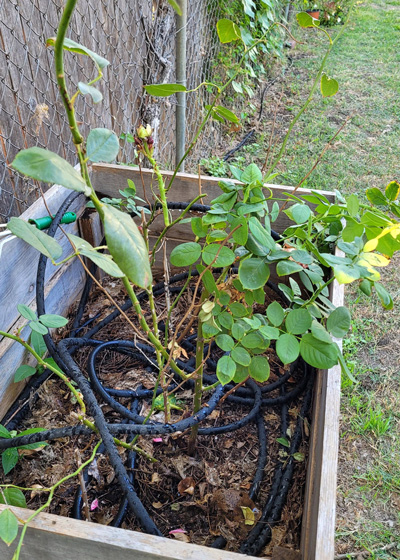
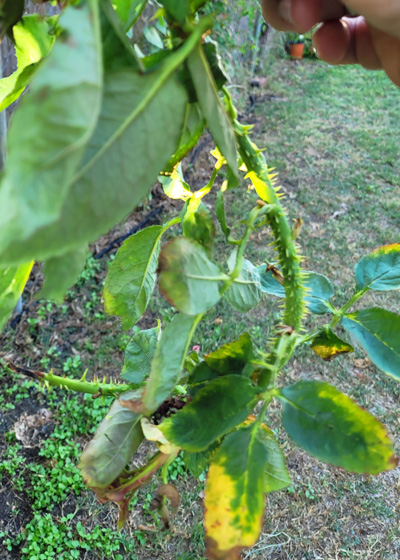
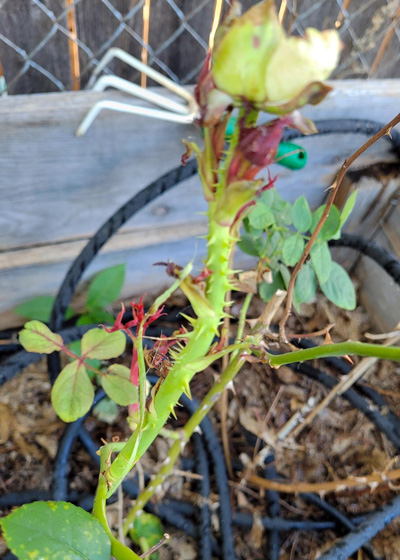
Answer: I have some very bad news for you. This is the fatal rose rosette virus. It has run rampant over roses in DFW and beyond for the past 12 or 14 years and now has spread across much of the rest of the state. Actually, it’s been around for many decades. It’s spread by a microscopic mite for which we have no preventive spray, and there is no cure for the virus. Sadly, all we can (and must) do is to remove and destroy the plants. The thorny stems are one of the key indicators. Here is information I’m leaving archived on my website about RRV.
QUESTION 7
WHY IS CAROLINA JESSAMINE SO LEGGY?
Question: I wanted to cover this fence with star jasmine, but it didn’t survive the freeze. Then I planted Carolina jessamine, but it’s very leggy. Any tips? It gets part sun – maybe half a day. Erin H., Keller.
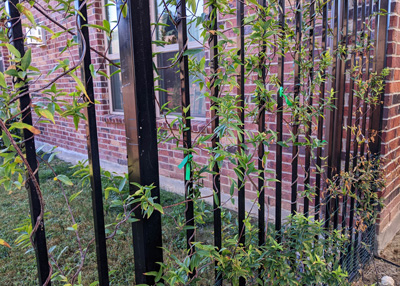
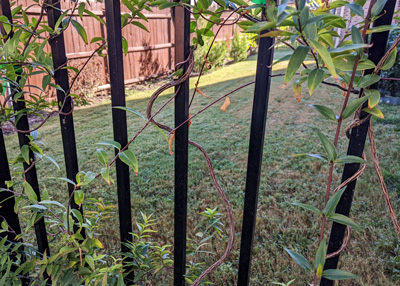
Answer: There are only three things that will make Carolina jessamine thicken up: ample moisture, generous nitrogen (lawn fertilizer sans weedkiller) and full or nearly full sunlight. It sounds and looks to me that boosting each of those three would be a good idea. I do note that a couple of shrubs, perhaps hollies, against your far fence, have turned brown, apparently from lack of water. It also looks like the bermuda may have been kept a bit dry. Those may give you some additional clues.
QUESTION 8
WHY HAS EMERALD ZOYSIA THINNED OUT?
Question: I planted Emerald zoysia last July (2021). It looked great through the rest of that growing season, but now it is mainly dirt. Is this possibly fungus, or has it dried out from the hot summer? Bill S., Frisco.


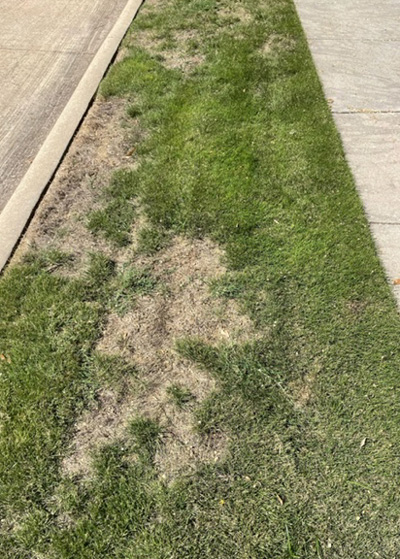
Answer: I can’t tell. There seem to be circular patches similar to what you would expect to see with large patch (brown patch). However, zoysias are also susceptible to gray leaf spot (summer) and take all patch (primarily spring). Both of those would have been diagnosed via close-up inspection of leaf blades which I can’t see here. This doesn’t look like drought damage since it is so very spotty (and circular). It’s really disappointing since you tried zoysia in the hopes of getting away from the maintenance issues we have with St. Augustine. If you replant with more Emerald, keep a close eye on the leaf blades next year to see if abnormalities develop.
QUESTION 9
WHAT CAUSES STICKY LEAVES ON PECANS AND BENEATH THE TREES?
Question: My old, very large pecan tree has sticky spots on the leaves. I park the car beneath the tree and it is covered with the sticky mess. What causes this? Lynn P., Campbell/Hunt.
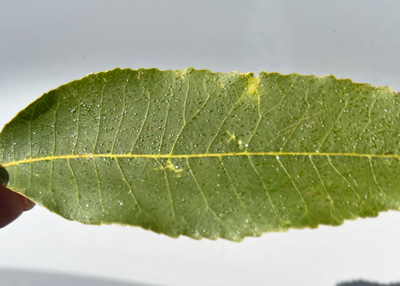
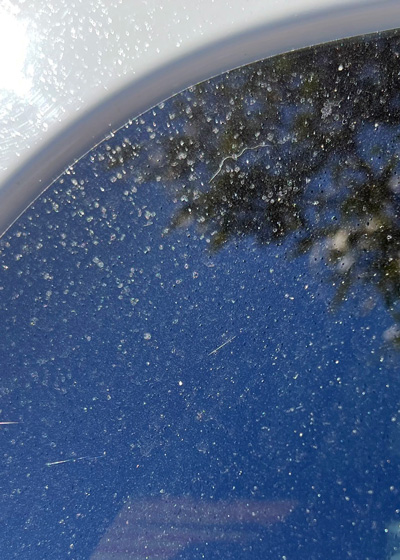
Answer: Pecan aphids. Please see my feature story from last week.
QUESTION 10
WHY IS THIS YEAR’S CELOSIA SO MUCH TALLER?
Question: I planted a single 4-inch pot of celosia last year. It did fine, growing to 18 inches tall. It died with the winter just as expected. Late this spring another celosia came up in the same spot. It is now more than 6 feet tall. What happened? Jay A., Colleyville.

Answer: You had a hybrid variety last year. It did not “come true” from seed in this second generation. Notice that you have several different flower forms. The same thing happens when we plant seeds from fruit or pecan trees or hybrid tomatoes. We don’t get the same variety back. The more generations that you allow seedlings to germinate and grow, the more similar they will be to prior generations.
QUESTION 11
WHAT EFFECT WOULD GRINDING THE ROOTS OF AN OLD LIVE OAK FLAT WITH THE GROUND HAVE?
Question: What would be the effect of grinding down the exposed roots of a 50-year-old live oak level with the ground? Johnny M., Allen.
Answer: The next year you would get to do it again because the roots would heal and grow up and out of the soil again. Live oaks have large buttressing roots. That’s just the way that they grow. They also cast heavy shade which leaves the ground beneath them bare of turf. You can solve both problems by planting a groundcover to camouflage the roots and cover the soil at the same time.
QUESTION 12
RECOMMENDATION FOR A LOW EVERGREEN SHRUB FOR SHADE
Question: What would be a good low evergreen shrub for an inside corner against a north-facing patio with heavy shade? Jack K., Brazos Co.
Answer: That’s a lot of restrictions. I’m going to start with dwarf hollies including dwarf yaupon, dwarf Chinese, Carissa and dwarf Burford. All can be kept at 30 to 48 inches. If you want something that would give the impact of a low shrub but that’s actually a tall groundcover, for Brazos County (where I grew up), you could plant aspidistra (cast iron plant), giant liriope or holly ferns. The “heavy shade” part of your request is what worried me the most.
